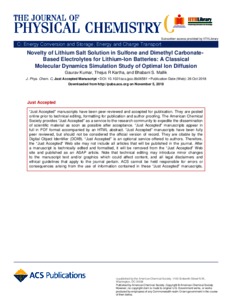Kumar, Gaurav and Kartha, Thejus R and Mallik, Bhabani Shankar
(2018)
Novelty of Lithium Salt Solution in Sulfone and Dimethyl Carbonate-Based Electrolytes for Lithium-Ion Batteries: A Classical Molecular Dynamics Simulation Study of Optimal Ion Diffusion.
Journal of Physical Chemistry C.
pp. 1-22.
ISSN 1932-7447
![[img]](http://raiithold.iith.ac.in/4513/1.hassmallThumbnailVersion/The%20Journal%20of%20Physical%20Chemistry_1-22_2018.pdf)  Preview |
|
Text
The Journal of Physical Chemistry_1-22_2018.pdf
- Published Version
Download (2MB)
| Preview
|
Abstract
The reduction in the usage of fossil fuel can be achieved by focusing on development of high-energy storage battery. Recently, tetramethylene sulfone (TMS) based electrolytes have become the center of attraction for Li-ion battery due to its high electrochemical and thermal stability. Our work uncovers the novel effect of adding dimethyl carbonate (DMC) to the mixture of TMS with LiPF6 solvent having different molar ratios of individual constituent by the classical Molecular Dynamics simulations. We calculated composite electrolyte properties such as solvation structures, diffusion coefficients, ionic conductivities and found that the coordination between Li+ and PF6- is least for DMC/TMS ratio of (1:2); because Li ions are found to be more coordinated with TMS molecules, which provides better structural stability to the system. Moreover, the transport properties of this system illustrate that the diffusion of ions is not so encouraging. But, while taking differ-ent concentrations of LiPF6 with the same molecular ratio of DMC/TMS, it was found that Li+ and PF6- have more diffusion coeffi-cient and ionic conductivities with the salt/solvent molar ratio of 1:20. However, due to strong interactions of Li-F, we propose a salt-solvent ratio of 1:12 as an appropriate choice based on optimal ion diffusion for better battery performance.
Actions (login required)
 |
View Item |


 Altmetric
Altmetric Altmetric
Altmetric